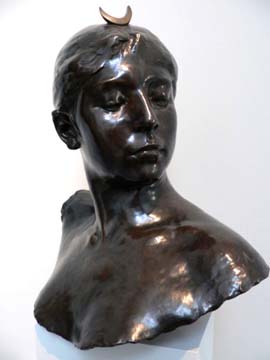
Jean-Alexandre-Joseph Falguiere
French, 1831-1900
Head of Diana, 1882 ca.
bronze
7 x 14 x 11 in.
SBMA, Museum purchase with funds provided by the Museum Collectors Council
1990.8

In 2001 SBMA purchased the full size Diana, 1882 c., with the General Acquisition Fund (2001.87).
RESEARCH PAPER
The Head of Diana by Falguiere is a bust in bronze in a dense black patina. Diana was first exhibited as a full length terra cotta statue at the Paris Salon of 1882. It received much acclaim. Five years later Diana was produced in marble, also fullsize, and then later as a bust in bronze. It was one of the most successful ideal heads produced during the second half of the nineteenth century. In fact it was so successful that the Diana bust was frequently reproduced in bronze and marble, varying in sizes from seven inches to thirty-nine inches. This Head of Diana is twenty-four inches, including marble base (head, only, seven inches), and was cast at the Thiebaut Freres foundry. The artist's name, A. Falguiere, can be found on her left shoulder.
Falguiere's career epitomized that of a successful academic artist, and he was at the height of his career when he created Diana . He was born in 1831 in Toulouse. In 1854 he entered the Ecole des Beaux-Arts. In 1859 he won the coveted Prix de Rome - - only two years after making his Salon debut. In 1864 he won a metal for his bronze The Winner of the Cockfight thus establishing his reputation. He continued to receive many honors and metals at the annual Paris Salons where he exhibited from 1857 to 1899.
As a successful artist Falguiere received much attention from the critics of the time. Lostalot strongly criticized Falguiere for portraying Diana totally nude, a direct contradiction to the concept of Diana, the chaste goddess, who allowed no man to see her naked body. (This, however, enhanced his career since this was post Resistance France, and Falguiere's nudes created a somewhat scandalous sensation - and all Parisiens enjoyed a good scandal!)
Another criticism was his choice of models. All of his friends could have easily named the model. Falguiere did not even try to avoid a facial resemblance. Binedite even suggested that perhaps Falguiere made plaster casts of his model -- an accusation that Rodin also suffered when he exhibited his male nude Age of Bronze at the May Salon of 1877.
As contemporaries, perhaps some aspects of Falguiere's Diana were influenced by Rodin, such as the jagged, irregular truncation of the bust. However, in 1899 the Societe des Gens de Lettres commissioned Falguiere to create a male statue, Balzac, to replace Rodin's work which they claimed they could not recognize as a statue of Balzac. Despite the defamation resulting from this, it is Rodin who is acknowledged today for changing the history of art.
Although Falguiere was a painter, he is probably best known for his statues of the female nudes: Eve, Diana, A Hunting Nymph, Fighting Bacchantes, Woman with a Peacock, Diana-Callisto, Heroic Poetry, and A Dancer. Due to their popularity many of these were frequently reproduced in reduced or bust-length form, such as this Head of Diana . By making both a full-size statue and a bust, it has been noted that perhaps Falguiere was following the precedent of the eighteenth century sculptor Houdon.
In this bust the only symbol of the goddess is the crescent moon. In classical mythology Diana (or Artemis) is known as the goddess of the Hunt and personification of the moon. The full size Diana is portrayed as just having released an arrow, with her right arm raised above her head, and her left hand holding her bow at hip level, and bearing her weight on her left leg in a enhancement stance. The bust is well balanced in the customary portraiture pyramidal form. When looking at the Head of Diana it is just as easy to visualize her as a dancer, perhaps even a Spanish dancer if there was a rose in her teeth. However, the haughty, arrogant expression of the lowered eyelids lends itself more to the mythological Diana - eternally young and beautiful, but vengeful toward those who offend her. (This, over the centuries, came to embody the notion of the seductive yet unattainable female.)
Dianas have been enjoyed as a dominant theme since French Renaissance art. (During the first half of the sixteenth century, a marble Diana group, possibly Greek, dating from the fourth century B.C., was imported by Francois I.) Dianas became even more popular after 1547 when Henri II succeeded to the throne. The inspiration was believed to be Diane de Pontiers, the king's mistress.
If you are wondering what Falguiere's inspiration was to create Dianas four centuries later, he was once quoted as confiding to a friend "I create a Diana because Dianas are successful!"
NOTES
1 Wellesley College Museum, "Diana in Late Nineteenth - Century Sculpture: A Theme in Variations," November 3 - December 31, 1989.
2 Ibid
BIBLIOGRAPHY
APPOLLO, Vol. no. CXI., No. 219, May 1980, p.106.
APPOLLO, Vol. no. CXII., No.225, Nov. 1980, p.144
The Cleveland Museum of Art, "Aspects of Nineteenth Century Sculpture", Dec. 10, 1975 - Feb. 1, 1976, pp. 22-23.
Fusco, Peter, "Falguiere, the Female Nude, and 'La Resistance"' , LOS ANGELES COUNTY MUSEUM of ART BULLETIN, Volume XXIII, 1977, pp. 36-49.
J.B. Speed Art Museum, "Nineteenth Century French Sculpture: Monuments for the Middle Class" , November 2 - December 5 1971, pp. 169-175.
Los Angeles County Museum of Art, "The Romantics to Rodin; French Nineteenth Century Sculpture from North American Collection', March 4 - May 25, 1980. pp. 255-256.
Wellesley College Museum, "Diana in Late Nineteenth Century Sculpture: A Theme in Variations" , Nov. 3 - Dec. 31, 1989.
Susan Gallagher, Santa Barbara Museum of Art Provisional Docent, Class of 1991 April 11, 1991
Prepared for the SBMA Docent website by Loree Gold, 2008
